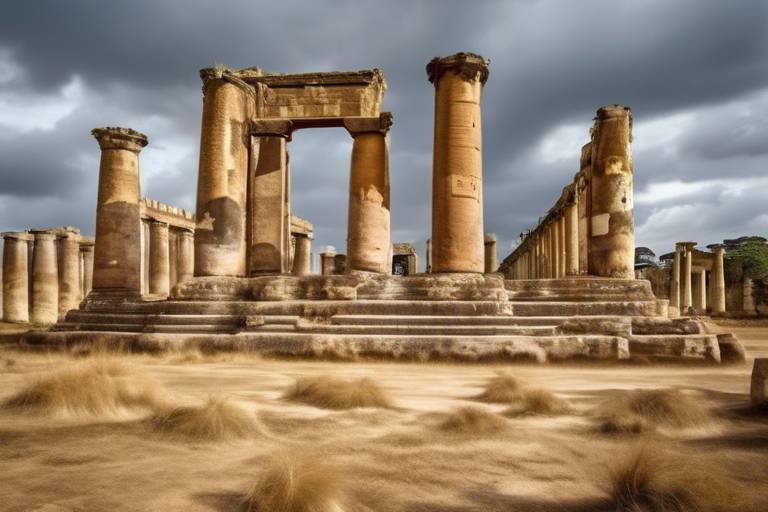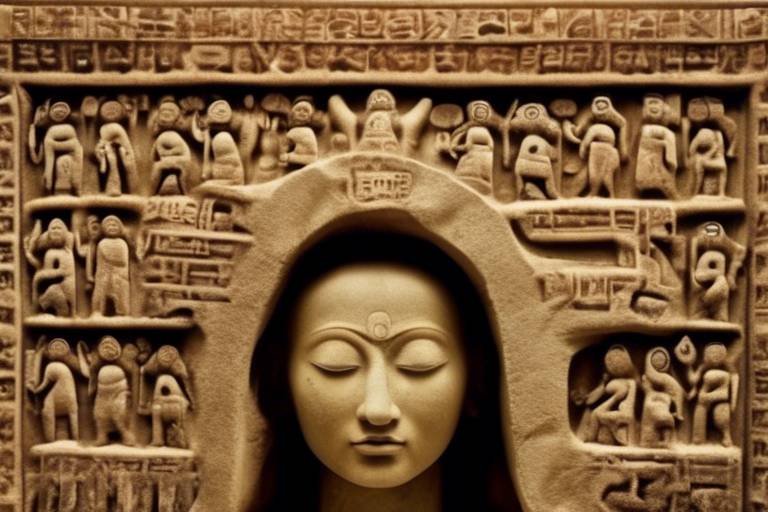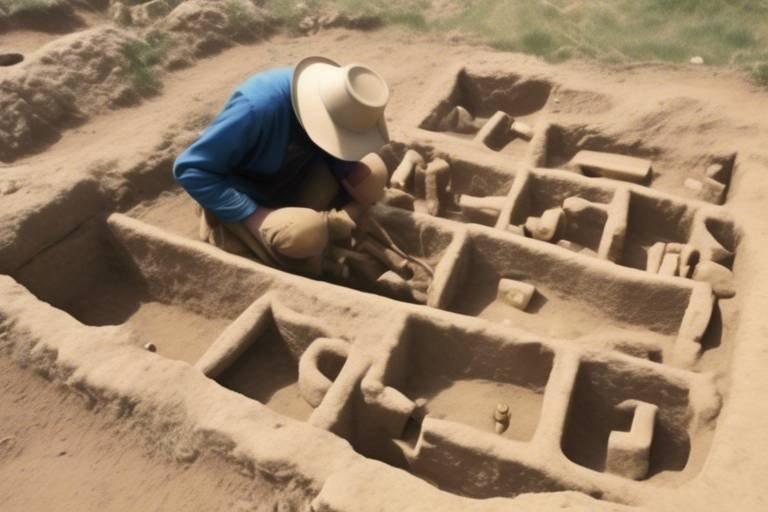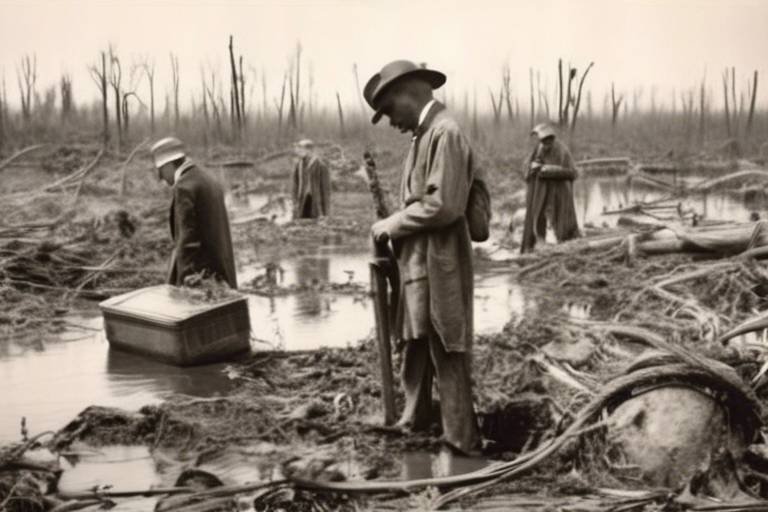The Role of Technology in Preserving Cultural Heritage
Preserving cultural heritage is a crucial endeavor that requires innovative solutions to safeguard the treasures of our past for future generations. Technology plays a pivotal role in this mission, offering a myriad of tools and techniques to ensure the longevity and accessibility of cultural artifacts, heritage sites, and traditions.
One of the most revolutionary applications of technology in cultural preservation is the use of 3D scanning and printing. By harnessing advanced scanning technologies, experts can create intricate replicas of artifacts and heritage sites with remarkable precision. These replicas not only help in the preservation of the originals but also facilitate in-depth study and analysis without the risk of damage.
Virtual reality tours have emerged as a powerful tool for cultural education and appreciation. Through immersive VR experiences, individuals can explore heritage sites and artifacts from anywhere in the world, transcending geographical boundaries and fostering a deeper understanding of diverse cultures.
Digital archiving is another vital aspect of cultural preservation, enabling the digitization of historical documents, photographs, and artworks. By preserving these materials in digital form, researchers and educators can access them easily while ensuring the protection of fragile physical originals.
Augmented reality exhibits have transformed the way we interact with history and culture. By overlaying digital information onto physical exhibits, AR technology enriches the visitor experience, making heritage sites come alive with interactive and informative content.
Remote sensing technologies such as LiDAR and satellite imaging play a crucial role in monitoring and safeguarding cultural heritage sites. These tools help in detecting potential threats like natural disasters and looting, allowing for timely interventions to protect these valuable assets.
Blockchain technology has revolutionized the authentication of cultural artifacts, providing secure and transparent systems to combat counterfeit goods in the market. By leveraging blockchain for authentication, the provenance and authenticity of heritage items can be verified with confidence.
Artificial intelligence has found its place in the restoration and conservation of cultural artifacts, paintings, and structures. AI algorithms assist experts in making informed decisions, enhancing the preservation process and ensuring that heritage items are maintained for future generations.
Mobile apps dedicated to cultural education offer interactive learning experiences that promote awareness and understanding of different cultures. These apps provide a platform for global audiences to engage with diverse heritage sites and traditions, fostering a sense of unity and appreciation for our shared cultural legacy.

3D Scanning and Printing
Exploring how technology is utilized to safeguard and conserve the world's cultural heritage sites, artifacts, and traditions, ensuring their longevity and accessibility for future generations.
3D scanning and printing technologies have revolutionized the preservation of cultural heritage by allowing for the creation of detailed replicas of artifacts and heritage sites. Through advanced scanning techniques, intricate details of historical objects can be captured with precision, enabling researchers and conservationists to study and analyze them without the risk of damage to the originals.
Imagine being able to hold a perfect replica of an ancient artifact in your hands, feeling its texture and examining its intricacies up close. This technology not only aids in preservation but also opens up new possibilities for education and research, providing invaluable insights into our rich cultural history.
Furthermore, 3D printing allows for the recreation of heritage sites in miniature scale, offering a tactile and visual experience that enhances our understanding and appreciation of these significant landmarks. Museums and educational institutions can now provide hands-on learning opportunities through these replicas, bringing history to life in a tangible way.
By combining the precision of 3D scanning with the creativity of 3D printing, the boundaries of cultural preservation are being pushed further, ensuring that the legacy of our past is not only protected but also made accessible to a wider audience.

Virtual Reality Tours
Virtual Reality (VR) tours have revolutionized the way we experience and interact with cultural heritage sites and artifacts. Imagine being able to transport yourself to the ancient wonders of the world or explore hidden treasures from the comfort of your own home. With VR technology, this is now possible.
Through immersive virtual reality experiences, individuals can embark on virtual journeys to iconic heritage sites such as the Great Wall of China, Machu Picchu, or the Egyptian pyramids. These tours offer a unique opportunity to explore these wonders up close, gaining a deeper understanding of their historical significance and architectural marvels.
Moreover, VR tours provide accessibility to individuals who may not have the means to travel physically to these locations. It opens doors to cultural exploration and education for people around the globe, transcending geographical boundaries and time constraints.
By donning a VR headset, users can walk through ancient ruins, inspect intricate details of artifacts, and even participate in virtual guided tours led by experts. The immersive nature of VR technology stimulates the senses, creating a sense of presence that traditional photos or videos cannot replicate.
Furthermore, VR tours offer a level of interactivity that enriches the learning experience. Users can engage with historical information, view 3D reconstructions of ancient structures, and uncover hidden stories behind cultural artifacts. This interactive element adds depth and engagement, making the exploration of heritage sites a truly captivating experience.

Digital Archiving
Digital archiving plays a crucial role in the preservation of cultural heritage by digitizing and safeguarding historical materials for future generations. Through the process of digital archiving, valuable documents, photographs, and artworks are transformed into electronic formats, ensuring their longevity and accessibility. This preservation method not only protects fragile physical materials from deterioration but also facilitates research, education, and widespread dissemination of cultural knowledge.
By creating digital archives, cultural institutions can store vast amounts of information in a compact and organized manner, making it easier for researchers, historians, and the general public to access and explore these valuable resources. Digital archiving also enables the restoration and conservation of deteriorating materials through digital manipulation and enhancement techniques, preserving them in their original form for posterity.
Furthermore, digital archiving allows for the creation of interactive exhibits and online galleries that showcase cultural artifacts and historical documents to a global audience. Through virtual platforms, individuals from diverse backgrounds can engage with and learn about different cultures, traditions, and heritage sites, fostering cross-cultural understanding and appreciation.

Augmented Reality Exhibits
Augmented Reality Exhibits revolutionize the traditional museum experience by seamlessly blending the physical and digital worlds, offering visitors a captivating journey through time and culture. Imagine standing in front of an ancient artifact, and with a simple scan through your smartphone, witnessing it come to life before your eyes. Through augmented reality overlays, visitors can delve deeper into the historical context, interact with 3D models, and uncover hidden stories behind each exhibit.
These innovative exhibits not only entertain but also educate, engaging visitors of all ages in a dynamic learning experience. By superimposing digital information onto the physical environment, augmented reality breathes new life into static displays, making history more accessible and engaging. Visitors can walk through ancient ruins, witness historical events unfold, and gain a deeper understanding of the cultural significance of each artifact.
Moreover, augmented reality technology allows museums and heritage sites to constantly refresh their exhibitions without the need for physical changes. Exhibits can be updated, expanded, or customized to suit different audiences, ensuring that each visit offers a unique and personalized experience. This flexibility not only attracts a wider range of visitors but also encourages repeat visits as there is always something new to discover.

Remote Sensing Technologies
Remote Sensing Technologies play a crucial role in the safeguarding and protection of cultural heritage sites around the world. By harnessing advanced tools such as LiDAR and satellite imaging, experts can remotely monitor these sites with unparalleled precision and detail. These technologies provide invaluable data that helps in detecting any potential threats to the heritage sites, including natural disasters, looting, or unauthorized construction.
LiDAR, which stands for Light Detection and Ranging, uses laser pulses to create detailed 3D maps of the terrain, allowing researchers to analyze the topography of cultural heritage sites with remarkable accuracy. Satellite imaging, on the other hand, offers a bird's-eye view of these sites, enabling experts to monitor changes in the landscape and detect any signs of deterioration or encroachment.
One of the key benefits of remote sensing technologies is their ability to provide real-time monitoring of cultural heritage sites, allowing for immediate intervention in case of emergencies. By continuously collecting data from these sites, researchers can identify and address potential risks before they escalate, ensuring the long-term preservation of these invaluable treasures.

Blockchain for Authentication
Blockchain technology has revolutionized the way cultural artifacts and heritage items are authenticated and protected in today's digital age. By leveraging the power of blockchain, a decentralized and secure system is created to verify the authenticity of valuable cultural pieces, combating the rampant issue of counterfeit goods in the global market. This technology ensures transparency and trust in the provenance of artifacts, providing a reliable way to track their origins and ownership history.

Artificial Intelligence in Restoration
Artificial intelligence (AI) plays a crucial role in the restoration and conservation of cultural artifacts, paintings, and structures. By harnessing the power of AI algorithms, experts in the field can make more informed decisions and carry out restoration projects with greater precision and efficiency. Imagine a digital assistant for art restoration, capable of analyzing intricate details, identifying patterns, and suggesting the most suitable techniques for preserving heritage items.
One of the key advantages of using artificial intelligence in restoration is its ability to process vast amounts of data quickly and accurately. AI algorithms can analyze historical records, scientific research, and visual data to develop comprehensive restoration plans tailored to each artifact's unique characteristics. This level of precision and customization ensures that heritage items are preserved in a way that respects their original form and cultural significance.
Moreover, artificial intelligence can assist in detecting damage, deterioration, and inconsistencies in cultural artifacts that may not be easily identifiable to the naked eye. By employing machine learning algorithms, experts can detect subtle changes in condition over time, allowing for proactive conservation measures to be implemented before irreversible damage occurs.
Additionally, AI technologies enable experts to simulate the effects of different restoration techniques in a virtual environment before applying them to the actual artifacts. This virtual testing process minimizes the risk of unintended consequences and helps conservators choose the most suitable approach for each restoration project, ensuring the long-term preservation of cultural heritage items.
Furthermore, artificial intelligence can aid in the documentation and cataloging of cultural artifacts, streamlining the inventory management process and facilitating easier access to information for researchers and historians. By digitizing and organizing data through AI-powered systems, museums and cultural institutions can enhance the efficiency of their conservation efforts and contribute to the overall safeguarding of our shared heritage.

Mobile Apps for Cultural Education
Mobile apps have revolutionized the way we engage with cultural education, bringing the world's heritage sites and traditions right to our fingertips. These apps offer a dynamic platform for users to immerse themselves in the rich tapestry of global cultures, providing interactive learning experiences that transcend geographical boundaries. By incorporating multimedia elements such as videos, images, and interactive maps, mobile apps make cultural education engaging and accessible to a diverse audience.
One of the key advantages of mobile apps for cultural education is their convenience and portability. Users can access a wealth of information about different cultures and heritage sites anytime, anywhere, making learning on-the-go a reality. Whether exploring ancient civilizations, traditional art forms, or historical landmarks, mobile apps cater to a wide range of interests and learning styles, making cultural education both informative and entertaining.
Furthermore, mobile apps for cultural education often feature gamified elements that enhance user engagement and retention. By incorporating quizzes, challenges, and interactive activities, these apps transform learning into a fun and interactive experience. Users can test their knowledge, earn rewards, and track their progress, making the learning process rewarding and enjoyable.
Moreover, mobile apps facilitate community engagement and collaboration by connecting users with like-minded individuals who share a passion for cultural heritage. Through social features such as discussion forums, virtual tours, and collaborative projects, users can interact, share insights, and learn from each other, fostering a sense of community and belonging.
In conclusion, mobile apps play a crucial role in promoting cultural awareness and understanding on a global scale. By leveraging technology to deliver engaging and interactive learning experiences, these apps empower users to explore the world's cultural heritage in a meaningful and immersive way. Whether you're a history buff, art enthusiast, or simply curious about the world around you, mobile apps for cultural education offer a gateway to a world of knowledge and discovery.
Frequently Asked Questions
- How does 3D scanning and printing contribute to preserving cultural heritage?
3D scanning and printing technologies allow for the creation of detailed replicas of cultural artifacts and heritage sites, ensuring their preservation and study without risking damage to the originals.
- What are virtual reality tours and how do they benefit cultural heritage preservation?
Virtual reality tours provide immersive experiences that enable individuals to explore cultural heritage sites and artifacts from anywhere, fostering greater appreciation and understanding of diverse cultures.
- How does digital archiving help in conserving cultural heritage?
Digital archiving preserves historical documents, photographs, and artworks digitally, ensuring their long-term conservation, accessibility for research and education, and protection of fragile physical materials.
- What is the role of augmented reality exhibits in showcasing cultural heritage?
Augmented reality exhibits enhance museum displays with interactive overlays, providing informative experiences that bring history and culture to life for visitors of all ages.
- How do remote sensing technologies contribute to the protection of cultural heritage sites?
Remote sensing technologies like LiDAR and satellite imaging are used to monitor and safeguard cultural heritage sites from natural disasters, looting, and other threats, ensuring their preservation for future generations.
- How is blockchain technology utilized in authenticating cultural artifacts?
Blockchain technology creates secure and transparent systems for authenticating cultural artifacts and heritage items, combating the spread of counterfeit goods in the global market.
- What role does artificial intelligence play in the restoration of cultural artifacts?
Artificial intelligence algorithms assist in the restoration and conservation of cultural artifacts, paintings, and structures, aiding experts in making informed decisions to preserve heritage items effectively.
- How do mobile apps contribute to cultural education and awareness?
Mobile applications offer interactive learning experiences about different cultures, traditions, and heritage sites, fostering cultural awareness and understanding among a global audience.



















